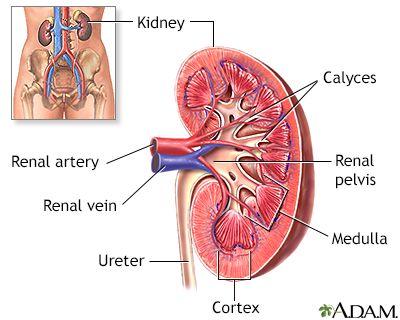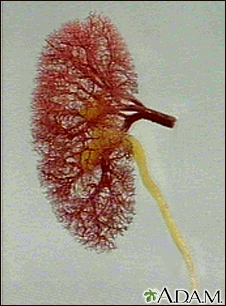Acute tubular necrosis
Necrosis - renal tubular; ATN; Necrosis - acute tubular
Acute tubular necrosis (ATN) is a kidney disorder involving damage to the tubule cells of the kidneys, which can lead to acute kidney failure. The tubules are tiny ducts in the kidneys that help filter the blood when it passes through the kidneys.
Images


I Would Like to Learn About:
Causes
ATN is often caused by a lack of blood flow and oxygen to the kidney tissues (ischemia of the kidneys). It may also occur if the kidney cells are damaged by a poison or harmful substance.
The internal structures of the kidney, particularly the tissues of the kidney tubule, become damaged or destroyed. ATN is one of the most common structural changes that can lead to acute kidney failure.
ATN is a common cause of kidney failure in people who are in the hospital. Risks for ATN include:
- Blood transfusion reaction
- Injury or trauma that damages the muscles
- Low blood pressure (hypotension) that lasts longer than 30 minutes
- Recent major surgery
- Septic shock (serious condition that occurs when a body-wide infection leads to dangerously low blood pressure)
Liver disease and kidney damage caused by diabetes (diabetic nephropathy) may make a person more prone to develop ATN.
ATN can also be caused by medicines that are toxic to the kidneys. These medicines include aminoglycoside antibiotics and the antifungal drug amphotericin.
Symptoms
Symptoms may include any of the following:
- Decreased consciousness, coma, delirium or confusion, drowsiness, and lethargy
- Decreased urine output or no urine output
- General swelling, fluid retention
- Nausea, vomiting
Exams and Tests
Your health care provider will perform a physical exam. Your provider may hear abnormal sounds when listening to the heart and lungs with a stethoscope. This is due to too much fluid in the body.
Tests that may be done include:
- Blood urea nitrogen (BUN) and serum creatinine
- Fractional excretion of sodium
- Kidney biopsy
- Urinalysis
- Urine sodium
- Urine specific gravity and urine osmolarity
Treatment
In most people, ATN is reversible. The goal of treatment is to prevent life-threatening complications of acute kidney failure
Treatment focuses on preventing the buildup of fluids and wastes, while allowing the kidneys to heal.
Treatment may include any of the following:
- Identifying and treating the underlying cause of the problem
- Restricting fluid intake
- Taking medicines to help control the potassium level in the blood
- Medicines taken by mouth or through an IV to help remove fluid from the body
Temporary dialysis can remove excess waste and fluids. This can help improve your symptoms so that you feel better. It may also make kidney failure easier to control. Dialysis may not be necessary for all people, but is often lifesaving, especially if potassium is dangerously high.
Dialysis may be needed in the following cases:
- Decreased mental status
- Fluid overload
- Increased potassium level
- Pericarditis (inflammation of the sac-like covering around the heart)
- Removal of toxins that are dangerous to the kidneys
- Total lack of urine production
- Uncontrolled buildup of nitrogen waste products
Outlook (Prognosis)
ATN can last for a few days to 6 weeks or more. This may be followed by 1 or 2 days of making an unusually large amount of urine as the kidneys recover. Kidney function often returns to normal, but there may be other serious problems and complications.
When to Contact a Medical Professional
Contact your provider if your urine output decreases or stops, or if you develop other symptoms of ATN.
Prevention
Promptly treating conditions that can lead to decreased blood flow as well as decreased oxygen to the kidneys can reduce the risk for ATN.
Blood transfusions are crossmatched to reduce the risk of incompatibility reactions.
Diabetes, liver disorders, and heart problems need to be managed well to reduce the risk for ATN.
If you know you're taking medicine that can injure your kidneys, ask your provider about having your blood level of the medicine checked regularly.
Drink a lot of fluids after having any contrast dyes to allow them to be removed from the body and reduce the risk for kidney damage.
Related Information
RenalAcute kidney failure
Hemolytic transfusion reaction
Septic shock
Shock
Diabetes and kidney disease
Chronic kidney disease
End-stage kidney disease
High blood pressure in adults - hypertension
References
Gunning S, Koyner JL. Acute tubular injury and acute tubular necrosis. In: Gilbert S, ed. National Kidney Foundation Primer on Kidney Diseases. 8th ed. Philadelphia, PA: Elsevier; 2023:chap 32.
Weisbord SD, Palevsky PM. Prevention and management of acute kidney injury. In: Yu ASL, Chertow GM, Luyckx VA, Marsden PA, Skorecki K, Taal MW, eds. Brenner and Rector's The Kidney. 11th ed. Philadelphia, PA: Elsevier; 2020:chap 29.
BACK TO TOPReview Date: 8/28/2023
Reviewed By: Walead Latif, MD, Nephrologist and Clinical Associate Professor, Rutgers Medical School, Newark, NJ. Review provided by VeriMed Healthcare Network. Also reviewed by David C. Dugdale, MD, Medical Director, Brenda Conaway, Editorial Director, and the A.D.A.M. Editorial team.

Health Content Provider
06/01/2025
|
A.D.A.M., Inc. is accredited by URAC, for Health Content Provider (www.urac.org). URAC's accreditation program is an independent audit to verify that A.D.A.M. follows rigorous standards of quality and accountability. A.D.A.M. is among the first to achieve this important distinction for online health information and services. Learn more about A.D.A.M.'s editorial policy, editorial process and privacy policy. A.D.A.M. is also a founding member of Hi-Ethics. This site complied with the HONcode standard for trustworthy health information from 1995 to 2022, after which HON (Health On the Net, a not-for-profit organization that promoted transparent and reliable health information online) was discontinued. |
The information provided herein should not be used during any medical emergency or for the diagnosis or treatment of any medical condition. A licensed medical professional should be consulted for diagnosis and treatment of any and all medical conditions. Links to other sites are provided for information only -- they do not constitute endorsements of those other sites. © 1997- 2025 A.D.A.M., a business unit of Ebix, Inc. Any duplication or distribution of the information contained herein is strictly prohibited.
